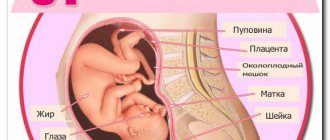The ultrasound examination procedure is familiar to all expectant mothers. During pregnancy, a woman undergoes this examination at least three times, and do not think about whether ultrasound is harmful to the fetus. After the ultrasound, the pregnant woman receives a report with a conclusion. The abundance of numbers and letter abbreviations is dizzying. Because of ignorance, only bad thoughts come to mind. And by the time the expectant mother gets an appointment with a gynecologist, her imagination will often paint gloomy pictures. A competent interpretation of ultrasound during pregnancy will help prevent this situation.
Features of diagnostics of the fetus and uterus
Ultrasound scanning is considered a universal, non-invasive, convenient and safe technique for examining patients. Its essence lies in the analysis of the transformation of mechanical vibrations of structures of various densities above the audible frequency. Ultrasound equipment uses the acoustic impedance of sound waves with a frequency of 2–10 MHz. During pregnancy, the examination does not cause discomfort or pain to either the mother or the baby - it is performed using a special sensor.
Subject to diagnosis:
- anatomical features of the developing baby;
- placenta – “child’s place”;
- umbilical cord - umbilical cord;
- amniotic fluid surrounding the fetus;
- the uterine cavity, its ligamentous apparatus and appendages.
The purpose of ultrasound is to assess the condition of the pregnant woman and the unborn baby, and to diagnose possible congenital and genetic syndromes. This is especially important in cases where there is a special indication - a hereditary predisposition to such anomalies.
Expectant mothers can be completely confident in the safety of ultrasound - ultrasonic waves do not have a teratogenic effect on the fetus and cannot provoke a disruption in its development
Interpretation of ultrasound during pregnancy allows you to determine the size of the fetus, the amount of amniotic fluid, the degree of premature aging of the placenta, its integrity and the place of attachment to the uterine wall. Practitioners use the indicators of this examination to choose tactics for managing the gestation period and preparing for the process of expulsion of the fetus.
Why do pregnant women undergo ultrasound?
Performing an ultrasound examination during pregnancy:
- helps analyze the condition of the fetus;
- identify congenital defects and developmental features of the child;
- diagnose deviations and complications during the gestation period.
The ultrasound diagnostic method is very popular because of its simplicity, accessibility, safety and great information content. It is part of three screening tests during pregnancy.
Ultrasound results are assessed only by the attending physician. Interpretation of the data obtained in the context of a specific woman with a certain medical history and pregnancy history is possible only by a person with a higher medical education. Independent interpretation of a fetal ultrasound is unacceptable, but knowledge and understanding of its main parameters will reassure the woman and improve mutual understanding between her and the doctor.
The procedure for conducting routine ultrasound examinations
When screening in the first trimester, the uterine cavity, its walls and appendages (ovaries and fallopian tubes) are examined. The doctor examines whether the embryo is developing normally and evaluates the indicators:
- the formation of the chorion - a fleecy membrane, which over time transforms into the placenta;
- the size and shape of the yellow sac, which is an embryonic organ with a supply of vital substances;
- thickness of the cervical fold - the size of the area between the soft tissues that surround the cervical spine and the baby’s skin.
In the second trimester, the condition of the fallopian tubes and ovaries is examined, fetal fetometry is performed (measurement of anatomical structures) and the correspondence of its parameters with the timing of pregnancy is assessed, the condition of the umbilical cord, placenta and the structure of the amniotic fluid is analyzed, the development of the heart and internal organs of the baby is studied, and its gender can be determined. An ultrasound performed at this stage of pregnancy can detect placental abruption, increased uterine tone, threat of miscarriage, existing fetal malformations and chromosomal defects.
When choosing a medical institution for ultrasound diagnostics, the expectant mother should give preference to clinical diagnostic centers that have high-quality modern equipment - this will allow her to obtain more accurate information about the condition of her baby.
Ultrasound scanning in the third trimester is carried out in conjunction with the Doppler procedure and has the following goals:
- assessment of the intensity of blood circulation in the vascular system of the umbilical cord and uterus, the fetal heart rate, the readiness of its lungs for functional activity in a normal environment;
- studying the baby's presentation and the possibility of umbilical cord entanglement;
- determination of his weight and height;
- identification of serious developmental defects that were not detected in the early stages - heart defects, cleft palate, cleft lip, etc.
Determination of gender
20 weeks is the right period of pregnancy to find out the sex of the baby. Since in the first trimester the baby is still underdeveloped, it is very difficult to examine his genitals. By the 20th week of pregnancy, if the child does not cover his genitals with his arm and leg, it is not difficult to establish his gender.
At this stage of development, in 95% of cases, an ultrasound can accurately show who the expectant mother is expecting: a daughter or a son.
Photo gallery
The photo gallery shows photographs showing what a boy looks like at 20 weeks of pregnancy and a photo showing a girl in the second trimester.
Girl
Boy
Interpretation of fetal ultrasound
During each study, the doctor takes certain measurements, their interpretation allows you to determine the size of the unborn child during its development. To make it more convenient for our readers to understand the examination protocol, we provide a table with the norms of ultrasound indicators:
| Gestation period (by weeks) | Weight (g) | Height (cm) | Heart rate (beats) | LZR (mm) 50th Ave. | BPR (mm) 50 | Coolant (mm) 50 | Exhaust gas (mm) 50 | KTE (mm) 50 | DKG (mm) 50 | DBC (mm) 50 | WPC (mm) 50 | DCP (mm) 50 | TVP (mm) 50 | |
| 10 | 4 | 3,1 | 165 | — | — | — | — | 31 | — | — | — | — | 1,5 | |
| 11 | 7 | 4.1 | 160 | — | 17 | 51 | 63 | 42 | — | 5,6 | — | — | 1,6 | |
| 12 | 14 | 5,4 | 155 | — | 21 | 61 | 71 | 53 | — | 7,3 | — | — | 1,6 | |
| 13 | 23 | 7,4 | 150 | — | 24 | 69 | 84 | 63 | — | 9,4 | — | — | 1,7 | |
| 14 | 43 | 8,7 | 165 | — | 27 | 78 | 97 | 76 | — | 12,4 | — | — | 1,7 | |
| 15 | 70 | 10,1 | — | — | 31 | 90 | 110 | — | — | 16,2 | — | — | — | |
| 16 | 100 | 11,6 | — | 45 | 34 | 102 | 124 | — | 18 | 20 | 18 | 15 | — | |
| 17 | 140 | 13 | — | 50 | 38 | 112 | 135 | — | 21 | 24 | 24 | 18 | — | |
| 18 | 190 | 14,2 | — | 54 | 42 | 124 | 146 | — | 24 | 27 | 27 | 20 | — | |
| 19 | 240 | 15,3 | — | 58 | 45 | 134 | 158 | — | 27 | 30 | 30 | 23 | — | |
| 20 | 300 | 16,4 | — | 62 | 48 | 144 | 170 | — | 30 | 33 | 33 | 26 | — | |
| 21 | 360 | 26,7 | — | 66 | 51 | 157 | 183 | — | 33 | 36 | 35 | 28 | — | |
| 22 | 430 | 27,8 | — | 70 | 54 | 169 | 195 | — | 35 | 39 | 38 | 30 | — | |
| 23 | 500 | 28,9 | — | 74 | 58 | 181 | 207 | — | 38 | 41 | 40 | 33 | — | |
| 24 | 600 | 30 | — | 78 | 61 | 193 | 219 | — | 40 | 44 | 43 | 35 | — | |
| 25 | 660 | 34,6 | — | 81 | 64 | 206 | 232 | — | 42 | 46 | 45 | 37 | — | |
| 26 | 700 | 35,6 | — | 85 | 67 | 217 | 243 | — | 45 | 49 | 47 | 39 | — | |
| 27 | 875 | 36,6 | — | 89 | 70 | 229 | 254 | — | 47 | 51 | 49 | 41 | — | |
| 28 | 1000 | 37,6 | — | 91 | 73 | 241 | 265 | — | 49 | 53 | 51 | 43 | — | |
| 29 | 1105 | 38,6 | — | 94 | 76 | 253 | 275 | — | 51 | 55 | 53 | 44 | — | |
| 30 | 1320 | 39,9 | — | 97 | 78 | 264 | 285 | — | 53 | 57 | 55 | 46 | — | |
| 31 | 1500 | 41,1 | — | 101 | 80 | 274 | 294 | — | 55 | 59 | 55 | 48 | — | |
| 32 | 1700 | 42,4 | — | 104 | 82 | 286 | 304 | — | 56 | 61 | 58 | 49 | — | |
| 33 | 1920 | 43,7 | — | 107 | 84 | 296 | 311 | — | 58 | 63 | 59 | 50 | — | |
| 34 | 2140 | 45 | — | 110 | 86 | 306 | 317 | — | 60 | 65 | 61 | 52 | — | |
| 35 | 2380 | 46,5 | — | 112 | 88 | 315 | 322 | — | 61 | 67 | 62 | 53 | — | |
| 36 | 2620 | 47,4 | — | 114 | 90 | 323 | 326 | — | 62 | 69 | 63 | 54 | — | |
| 37 | 2850 | 48,6 | — | 116 | 92 | 330 | 330 | — | 64 | 71 | 64 | 55 | — | |
| 38 | 3080 | 49,7 | — | 118 | 94 | 336 | 333 | — | 65 | 73 | 65 | 56 | — | |
| 39 | 3290 | 50,7 | — | 119 | 95 | 342 | 335 | — | 66 | 74 | 66 | 57 | — | |
| 40 | 3460 | 51,2 | — | 120 | 96 | 347 | 337 | — | 67 | 75 | 67 | 58 | — | |
Interpretation of abbreviated terms:
- HR – fetal heart rate;
- LZR (fronto-occipital size), BPR (bi-parietal) – dimensions of the head;
- Coolant and exhaust gas – circumference of the head and abdomen;
- KTP – coccygeal-parietal size;
- DC and DB - length of the tibia and femur bones;
- KDP and DKP - the length of the humerus and forearm bones;
- TVP—thickness of the collar space;
- 50th Ave (percentile) – the average value typical for a certain stage of pregnancy.
The table shows average parameters and you need to take into account that your baby may differ from them! Now let's take a closer look at the final data of each of the three mandatory prenatal (antenatal) screenings, which are aimed at identifying the risk of developing pathological processes.
Table of ultrasound results during pregnancy
Most doctors use special tables that help determine not only the size of the fetus, but also its height and weight, and this table will help us in deciphering ultrasound during pregnancy.
| A week | 11 | 12 | 13 | 14 | 15 | 16 | 17 | 18 | 19 | 20 |
| Height, cm | 6,8 | 8,2 | 10,0 | 12,3 | 14,2 | 16,4 | 18,0 | 20,3 | 22,1 | 24,1 |
| Weight, g | 11 | 19 | 31 | 52 | 77 | 118 | 160 | 217 | 270 | 345 |
| BRGP | 18 | 21 | 24 | 28 | 32 | 35 | 39 | 42 | 44 | 47 |
| Dlb | 7 | 9 | 12 | 16 | 19 | 22 | 14 | 28 | 31 | 34 |
| DGrK | 20 | 24 | 24 | 26 | 28 | 34 | 38 | 41 | 44 | 48 |
| A week | 21 | 22 | 23 | 24 | 25 | 26 | 27 | 28 | 29 | 30 |
| Height, cm | 25,9 | 27,8 | 29,7 | 31,2 | 32,4 | 33,9 | 35,5 | 37,2 | 38,6 | 39,9 |
| Weight, g | 416 | 506 | 607 | 733 | 844 | 969 | 1135 | 1319 | 1482 | 1636 |
| BRGP | 50 | 53 | 56 | 60 | 63 | 66 | 69 | 73 | 76 | 78 |
| Dlb | 37 | 40 | 43 | 46 | 48 | 51 | 53 | 55 | 57 | 59 |
| DGrK | 50 | 53 | 56 | 59 | 62 | 64 | 69 | 73 | 76 | 79 |
| A week | 31 | 32 | 33 | 34 | 35 | 36 | 37 | 38 | 39 | 40 |
| Height, cm | 41,1 | 42,3 | 43,6 | 44,5 | 45,4 | 46,6 | 47,9 | 49,0 | 50,2 | 51,3 |
| Weight, g | 1779 | 1930 | 2088 | 2248 | 2414 | 2612 | 2820 | 2992 | 3170 | 3373 |
| BRGP | 80 | 82 | 84 | 86 | 88 | 89,5 | 91 | 92 | 93 | 94,5 |
| Dlb | 61 | 63 | 65 | 66 | 67 | 69 | 71 | 73 | 75 | 77 |
| DGrK | 81 | 83 | 85 | 88 | 91 | 94 | 97 | 99 | 101 | 103 |
BRGP (BPR) – biparietal head size. DB – thigh length. DGrK – chest diameter. Weight - in grams, height - in centimeters, BRGP, DB and DGrK - in millimeters.
Ultrasound between 11 and 14 weeks
During the first examination of a woman expecting a child, the presence of gross defects can be detected and the risk of chromosomal abnormalities can be assessed. A qualified specialist calculates the gestational age based on the date of the first day of the last monthly bleeding and the ultrasound scan data at the time of its conduct.
Based on the data of the first ultrasound examination, the doctor sets the expected date of delivery - it should correspond to a period of 40 weeks
The most important indicators that must be determined at the first screening are TVP, which reflects the amount of subcutaneous fluid on the back of the neck, and CTE, which indicates the size of the fetus. An increase in parameters may indicate the presence of trisomy 21 chromosome (or Down syndrome), and the expectant mother will need to undergo prenatal karyotyping. In addition, the following parameters are assessed at the first ultrasound scan.
Formation of anatomical structures of the embryo:
At what stage can the fetal heartbeat be heard on ultrasound?
- bones of the cranial vault and limbs;
- spinal column;
- brain;
- stomach;
- anterior wall of the peritoneum;
- Bladder.
Extra-embryonic organs: yolk sac - a temporarily existing organ (up to 12 weeks) necessary for the formation of an embryo; measuring its internal diameter is important for diagnosing frozen pregnancy; chorion - the outer embryonic membrane covered with villi; studying its thickness and localization allows the obstetrician-gynecologist to have an idea about the development of the placenta, possible Rh conflict, intrauterine infection or malnutrition of the fetus.
The structure of the uterus, ovaries, fallopian tubes and the condition of the mucous layer (endometrium) are assessed - this is necessary to choose the optimal tactics for managing pregnancy and childbirth. In case of multiple pregnancy, the ultrasound specialist examines the parameters of each baby separately.
Why are ultrasounds needed during pregnancy?
So, there are two types of ultrasounds: screening and selective .
- The first are carried out at certain dates and are mandatory for all women expecting a baby. Referrals for routine examinations are issued by the doctor who is managing the pregnancy at 10-12, 22-24, 32 and 37-38 weeks. During the ultrasound, the presence or absence of defects in the fetus is revealed, the baby’s parameters are measured, the uterus and placenta are examined, the amount of amniotic fluid is studied, then the doctor gives a conclusion about the pregnancy’s compliance with a certain period.
- Ultrasounds of the second type are performed strictly for medical reasons if any disease or unfavorable course of pregnancy is suspected. If pathology is suspected, the frequency of such studies can reach three times a week.
Peculiarities of evaluation of parameters obtained during screening 2
To assess the anatomical features of the fetal structure, the optimal period is considered to be from 20 to 24 weeks - developmental defects identified during this period allow doctors to determine further actions. The ultrasound protocol contains the main indicators of fetometry - the size of the fetus, the structure of the umbilical cord and amniotic fluid, the nature of the presentation of the fetus, the anatomy of organs and systems - it is at this stage of pregnancy that many developmental pathologies appear.
The procedure for measuring anatomical structures is as follows:
- head - determined by the integrity of the bones, the presence of extra- and intracranial formations, the cerebral hemispheres, cerebellum, lateral ventricles, visual tuberosities and subarachnoid cisterns are studied;
- face – the condition of the profile, nasolabial triangle, orbits is assessed and markers of chromosomal abnormalities are carried out;
- spinal column - the transverse and longitudinal structure is examined to identify hernial protrusion, spina bifida and defects in the formation of the spinal cord;
- lungs - the size, presence of neoplasms and accumulation of effusion in the pleural cavity are studied;
- heart - its location, size, presence of changes in the pericardium and integrity of the interchamber septa are assessed;
- abdominal organs - the size and location of the stomach and intestines, the presence of hernia, dropsy, hepatosplenomegaly are determined;
- urinary system - the shape, location of the kidneys and bladder, their size and structure are examined;
- limbs.
Ultrasound scanning of provisional (temporarily existing) organs allows qualified specialists to indirectly assess the condition of the fetus, its developmental defects, the presence of intrauterine infections and other conditions requiring correction
In addition to these indicators, the cervix and uterine appendages and endometrial walls must be examined. Based on the second ultrasound, the obstetrician-gynecologist can conclude that there are any pathologies and give the expectant mother appropriate recommendations.
When and how does the research take place?
Routine ultrasound examinations are carried out three times: at 12, 20, and 32 weeks. The normal course of pregnancy gives reason to carry out fetometric diagnostics during the same period.
The procedure is carried out in two ways:
- transvaginally - a vaginal sensor is inserted into the vagina.
- transabdominal - the contents of the uterus are viewed through the external abdominal wall.
During the examination, the doctor takes measurements of the fetal organs on the monitor screen, then makes a diagnosis about the correct development and formation of individual organs.
Additionally, fetometric analysis is usually carried out in the following cases:
- the mother's condition is of concern to the gynecologist;
- there is a suspicion of a violation of intrauterine development of the fetus.
Ultrasound screening indicators 3
A study conducted at 32 weeks makes it possible to detect fetal anomalies that appear at a later stage, determine the biophysical profile, assess the presence of developmental delay syndrome, carry out the necessary treatment and preventive measures, and study the possibilities of timely delivery. Important points of the third ultrasound scan, which are taken into account when choosing tactics for gentle childbirth, are the determination of the expected weight of the child and his presentation (cephalic, transverse or pelvic).
To assess the functional state of the fetus, a special index is used, which is determined based on the summation of the final cardiotocography data:
- normal indicator – from 12 to 8 points;
- possible complications are indicated by a score from 7 to 6;
- a severe lack of oxygen (intrauterine hypoxia) and a high risk of losing the baby is indicated by a score below 5 points.
Accuracy of the study
An error during an ultrasound examination occurs in 5% of 100 cases.
There are several reasons why the study is wrong in its data:
- outdated equipment;
- unqualified doctor;
- short gestational age;
- features of maternal anatomy.
Diagnoses that can be mistaken by ultrasound:
- frozen pregnancy;
- ectopic pregnancy;
- false absence of pregnancy;
- genetic diseases of the fetus;
- gender of the child.
What do deviations from normal ultrasound readings mean?
Prenatal screening is carried out to assess the anatomical features of the fetus by measuring the main dimensions of the head, abdomen, and limbs. Based on these parameters, the correspondence of the gestational age to the date of the last monthly bleeding is established - this is done to exclude intrauterine growth retardation. Most often, this syndrome occurs in the third trimester and can be caused by:
- harmful habits of the expectant mother;
- diseases of the urinary and respiratory organs;
- arterial hypertension;
- infectious diseases;
- anomalies in the structure of the organs of the reproductive system;
- violations of the monthly bleeding cycle;
- multiple pregnancy;
- low or polyhydramnios;
- gestosis;
- primary infertility;
- complicated course of previous pregnancies;
- premature placental abruption;
- intrauterine infection;
- abnormalities of fetal formation.
If the parameters of the fetal size differ slightly from the norm, this is most likely evidence of the developmental characteristics of a particular baby
When performing an ultrasound scan at a later stage, the doctor examines the structure of the baby’s organs and diagnoses possible congenital developmental pathologies. The reasons contributing to their occurrence are considered to be heredity - defects are transmitted from parents through gene mutations, the teratogenic effects of certain medications, harmful working conditions of parents, previous infectious diseases, ionizing rays, toxic substances, mechanical factors - incorrect position of the child or the presence of tumor-like formations in the mother uterus), maternal injury in the first trimester.
If the head circumference parameters exceed normal values, the doctor evaluates the size of the tummy circumference and the length of the bones of the limbs - not all babies develop proportionally and the head may be larger than the rest of the body. A significant increase in biparietal (distance between the temporal bones) and fronto-occipital dimensions indicates the presence of tumor-like neoplasms in the brain or on the bones of the skull, encephalocele - cranial hernia, hydrocephalus - hydrocephalus.
These anomalies are considered very severe and incompatible with life - premature termination of pregnancy is required. A decrease in BPD and LZR indicates intrauterine growth retardation syndrome and requires corrective measures - the use of drugs that improve uteroplacental circulation and ensure timely delivery of nutrients to the fetus. Otherwise, such defects will lead to the death of the baby.
With a significant decrease in the size of the fetal head, underdevelopment or absence of the cerebral hemispheres (paired formations united by the corpus callosum into the brain) or the cerebellum (the small brain responsible for motor function) may be observed. In this situation, it is necessary to terminate the pregnancy.
The role of fetometry in assessing fetal development
The parameters and dimensions of the fetus obtained during fetometric analysis allow the doctor to more accurately determine:
- child health (for example, intrauterine growth retardation);
- mother's condition;
- date and outcome of the upcoming birth.
By changing the size of individual organs, the development of syndromes can be detected:
- Down;
- Patau;
- Edwards;
- Smith-Lemli-Opitz;
- Miller-Dicker;
- Williams;
- Angelman.
Carrying out ultrasound diagnostics
At the twenty-week period, there is no need to prepare for the study in advance (drink water and take carminative medications). Gas formation in the intestines is not a hindrance, since it moves from its usual place under the pressure of the uterus, and a sufficient amount of fluid provides the volume of amniotic (amniotic) fluid.
Ultrasound is performed in the abdominal (external) way, by moving the sensor across the patient’s abdomen. Ultrasonic waves are reflected from the objects being examined and transmitted to the monitor. Scanning can be done using 2D, 3D and 4D methods. In the last two options, the image of the fetus is three-dimensional, and the procedure takes a longer period of time. At the request of the parents, the doctor can print out a photo of the baby.
Photo from an ultrasound scan at twenty weeks of pregnancy
According to indications, the doctor prescribes an additional Doppler ultrasound - a study of the vascular system and the speed of blood flow between the three components that are assessed (the female body, the fetus, the placenta). In some cases, when the gynecologist suggests premature dilation of the isthmus and cervix (isthmic-cervical insufficiency), ultrasound can be performed transvaginally.
Probability of error
Any woman can quite rightly consider that the size of the embryo is not the most reliable indicator for setting the due date, because each child develops differently and it is difficult to determine its exact age. But in fact, after years of medical practice, there is no longer any doubt about the correctness of the fetal due date established on ultrasound.
If a woman still questions the ultrasound results, she can always carry out a number of additional diagnostic procedures, which in turn will allow her to determine the timing at the most accurate level.
Fetal ultrasound is not only a method of monitoring the condition of the fetus, monitoring its development, but also a completely reliable, accurate, informative, convenient and simple way to determine the period by week. Based on many parameters, which have already been quite fully studied over the years of development of ultrasound medicine, the diagnostician quickly determines the obstetric “age” of the embryo, using special tables that a simple patient can rely on.











